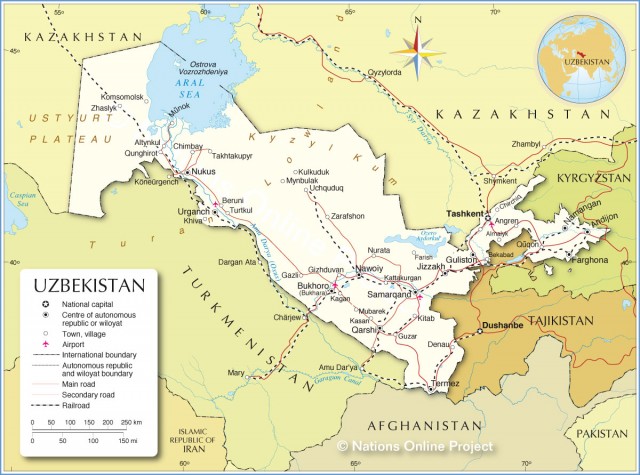Uzbekistan
Area 172,742 square mi (447,400 square km)
Population 30.76 million 2014
Capital Tashkent
Highest Point 14,111 ft (4,301 m)
Lowest Point -39ft (-12 m)
GDP $62.64 billion 2014
Primary Natural Resources natural gas, petroleum, coal.
THE REPUBLIC OF Uzbekistan, the most populous Central Asian republic of the former Soviet Union, is one of the world’s only countries that is LANDLOCKED and bordered entirely by other landlocked states (LIECHTENSTEIN is the other). Achieving its independence in 1991 following the Soviet Union’s collapse, Uzbekistan has the potential to become the region’s most prosperous country. It is located at the heart of Central Asia, and bordering countries include KAZAKHSTAN to the north and west, TURKMENISTAN to the southwest and south, AFGHANISTAN to the southeast, and TAJIKISTAN and KYRGYZSTAN to the east. Uzbekistan is steeped in history, being home to the ancient SILK ROAD centers of Bukara, Kiva, and SAMARQAND. For its part, Samarqand is home to the famed Registan, considered the “Taj Mahal” of Central Asia. The shrinking ARAL SEA, extending into Uzbekistan’s northwest Karakal-pakistan province, represents one of the worst ecological disasters in world history.

The physical landscape of Uzbekistan is primarily made up of deserts. The lone exception is the country’s easternmost areas, which contain semi-arid STEPPE grasslands. The river valleys of the Syr Darya, AMU DARYA, and Zarafshon are intensively irrigated for farming. Major lakes in Uzbekistan include the aforementioned Aral Sea and Aidarkul Lake, located just southwest of TASHKENT.
The heavily populated Ferghana valley to the east is surrounded by the mountains of Kyrgyzstan and Tajikistan. Uzbekistan’s most important natural resources are its natural gas, petroleum, and gold deposits. The importance of gold to Uzbekistan’s economy is demonstrated by the Muruntau Gold Mine, which during the mid-1990s was the largest gold mine in the world. Areas of Uzbekistan are seismically active, and much of the capital city of Tashkent was destroyed by a 1966 earthquake.
The distribution of Uzbekistan’s population is mainly concentrated in the Ferghana valley, centered on the cities of Tashkent (population: 2,295,300), Namangan (442,300), and Andijon (362,600). Uzbekistan’s third-largest city, Samarqand (419,600), is located well to the southwest of the Ferghana valley. The population’s ethnic composition includes Uzbek (80 percent), Russian (5.5 percent), Tajik (5 percent), Kazakh (3 percent), Karakalpak (2.5 percent), and Tatar (1.5 percent) peoples. The primary language spoken in Uzbekistan is Uzbek (spoken by 74 percent of the population), and significant numbers of citizens speak Russian (14 percent) and Tajik (4 percent).
Like the other countries of Central Asia, the dominant religion in Uzbekistan is ISLAM (88 percent of the population), with sizable numbers adhering to Eastern Orthodox (9 percent). Given its endowment of human and natural resources, Uzbekistan has the potential to become Central Asia’s most prosperous economy. Currently, however, agriculture remains the dominant sector, employing 44 percent of the labor force. Cotton, or “white gold,” remains the most important agricultural crop. Uzbekistan is the world’s second-largest exporter of cotton. Other agricultural products include vegetables, fruits, grain, and livestock. Industrial production, employing 20 percent of Uzbekistan’s labor force, is limited to natural gas, oil, gold, chemicals, and agricultural machinery.
Perhaps the most pressing geographical/political issue facing Uzbekistan is its complex eastern boundary with Kyrgyzstan and Tajikistan. Boundary delimitation is not settled with either of these countries. In addition, this complex boundary structure has relegated sizable Uzbek populations to reside outside of Uzbekistan. Nearly 25 percent of Tajikistan’s population are ethnic Uzbeks, while in Kyrgyzstan Uzbeks comprise 14 percent of the population. The major ecological challenge facing Uzbekistan is the disappearing Aral Sea and the associated pollution, infant mortality, cancer, and tuberculosis. Average life expectancy in Uzbekistan as a whole is just over 64 years, although in the Karakalpakistan villages surrounding the Aral Sea, this figure is as low as 38 years.